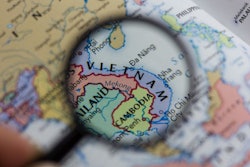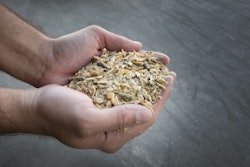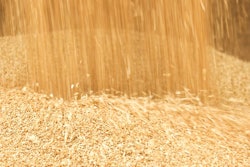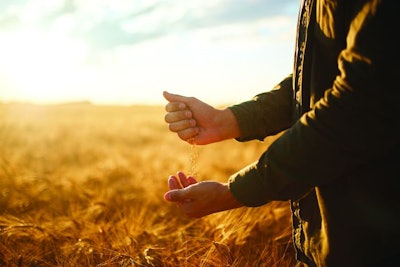
While farming is a crucial part of the EU’s economy, stricter environmental rules and more focus on regenerative agriculture and animal welfare are high on the political agenda. For animal feed and health, this has a number of implications.
The awareness about the vulnerability of the environment and planet earth seems to be greater than ever before. Spurred by COVID-19, droughts, bushfires and floods, we realize that we have only one planet on which to live and to grow our food.
Some might have seen this exercise at a conference or their kids’ schools. It’s an exercise where the speaker or teacher takes an apple and slices it into pieces to get rid of all the material that we cannot grow food on. Start with the oceans and lakes, ice, swamps, deserts and mountains, then cut away the areas that are buried under cities, highways, suburbs, shopping centers and other structures people have built. What’s left is 1/32nd piece of the apple, representing the amount of land available to grow food and feed for humans and animals.
This “Earth as an apple” activity shows us how very little arable land we have in the world. And what we do have available is also in high demand for other purposes than farming.
Intensification increases pressure
Over the years, an increasing area of farmland in Europe has been purchased from farmers to be exploited for buildings, houses and roads in the era of urban sprawl or used to bring back nature, as being part of EU’s biodiversity strategies and goals. This has resulted in a drop in the number of livestock farmers.
Analysis by the Guardian shows that, between 2005 and 2016, the number of poultry and livestock farms in the EU (excluding Croatia), dropped to 5.6 million — a reduction of 3.4 million. However, the number of animals have increased, reflecting the intensification of farms and loss of small farms.
A set of current measures and regulations and the reforms in the EU’s Common Agricultural Policy (CAP) are aimed to make sure the intensification does not lead to more environmental pressure (nitrogen, methane, zinc losses), more antibiotic use (because of the larger herds) and loss of natural resources and biodiversity, among others. The recent reforms to the CAP include measures to encourage farmers to leave more space for wildlife, to adopt organic standards for livestock, to use less chemical fertilizer and pesticide, and to nurture healthy soils. And this is reinforced with concrete (and ambitious) targets for 2030.
At least 25% of the EU’s agricultural land should be organic and a significant increase in organic aquaculture should be realized by 2030. In 2019, “only” 8.5% of the land was farmed as organic.
In addition, the use and risk of pesticides should be reduced by 50%, the use of fertilizers should drop by at least 20% and the sales of antimicrobials used for farmed animals and aquaculture should be reduced by 50%.
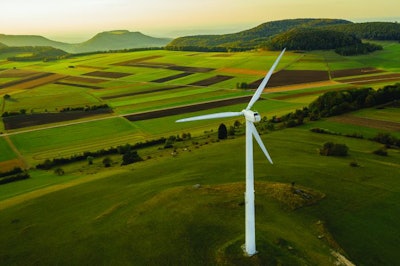 While the EU wants to promote organic farming, some question if there are enough certified feed ingredients available for poultry and livestock farmers to convert from traditional to organic feed. (Mlenny | iStock.com)
While the EU wants to promote organic farming, some question if there are enough certified feed ingredients available for poultry and livestock farmers to convert from traditional to organic feed. (Mlenny | iStock.com)ZnO and antibiotic changes
It is clear that the EU would like to protect its farmers, but also wants to stay in control and balance farming with protection of the environment and nature. This also has implications for animal nutrition.
A number of new legislation packages will come into effect soon in the EU. A big one is the ban of therapeutic use (up to 2,500 ppm) of zinc oxide (ZnO) in pig feed as of June 2022. Some countries already banned the high levels, such as the Netherlands in 2018.
The main issue concerning the high levels of ZnO is related to a potential environmental concern related to groundwater, drainage and the run-off of zinc to surface water. Acid sandy soils are most vulnerable to these processes. Animals excrete all the excess of zinc that exceeds physiological requirements. In addition, high levels of ZnO can also contribute to the acquisition and spread of antibiotic resistance genes. The use of zinc as a feed additive (at max levels of 150 ppm) to meet the animals’ zinc requirements will not be banned in the EU.
We also see things happening in antibiotic regulation.
The Veterinary Medicines Regulation [Regulation (EU) 2019/6] will modernize the existing rules on the authorization and use of veterinary medicines in the EU when it becomes applicable on January 28, 2022. It contains new measures for increasing the availability and safety of veterinary medicines and enhances EU action against antimicrobial resistance.
While the use of preventive in-feed antibiotics has already been banned in the EU since 2006, the updated regulation will prohibit all forms of routine antibiotic use in farming, including preventative group treatments or to compensate for poor hygiene, or inadequate animal husbandry or lack of care or to compensate for poor farm management.
Lack of organic feed ingredients
The EU’s decision to increase the area of organic agricultural land and organic aquaculture also has implications for animal diets. While organic farming practices have positive effects on pollination, biodiversity, animal welfare and farm profitability (farm premiums for organic produce), it often requires more farmland for livestock farmers and access to enough and quality organic feed ingredients. The latter is a challenge.
The EU allows 5% of the diet to consist of non-organic feed ingredients as addition to the proteins in the diet. In the past, there was talk of reducing that to 0%, meaning that all ingredients for organically farmed animals should come from organic resources. Because of the limited availability of organic feed ingredients, in 2017, this decision was postponed. With the ambition to increase organic farming in the EU, it is questioned if there are enough certified feed ingredients available for farmers that make the decision to convert from traditional to organic.
At the same time, the EU is updating its organic legal frameworks. An updated list of authorized products and substances for use in organic production are part of the new legislation 2021/1165 was published in July in the official journal of the EU. This new legal act repeals some measures in Regulation (EC) 889/2008 including annexes V (feed additives) and VI (feed materials) and replaces these annexes with an Annex III to Regulation 2021/1165. The Annex III now contains a list of feed materials (Part A) and feed additives (Part B) that are allowed for organic production from January 1, 2022.
Some of the changes include inclusion of the ID number from the catalogue of feed materials (68/2013) so there is no confusion which product it is about, and reference to an alternative manner to describe ID numbers or functional groups in the attempt to better identify possible uses of feed additives.
This “newly crafted” list is aimed at providing increased transparency and clarity to feed business operators with regard to feed materials and feed additives that are allowed in organic production. This fits into one of the action points in the EU’s Farm to Fork Strategy to contribute to a more sustainable food production system by revising the feed additives regulation and establishing new criteria to promote the authorization and use of innovative feed additives, particularly those contributing to reducing the use of antibiotics, improving animal welfare and mitigating climate change effects linked to livestock farming.
Feed ban eased after 20 years
A breakthrough in EU legislation related to animal nutrition is the allowance of use non-ruminant processed animal proteins (PAP’s), including insect meal to non-ruminant animals, i.e. pig and poultry.
For more than 20 years, the TSE regulation EC 999/2001 (also known as the feed ban) did not allow the use of animal-derived proteins to feed back to livestock animals to avoid the spread of bovine spongiform encephalopathy (BSE). And that included insects as well, as there was simply no other way than to label them livestock in the regulatory framework.
In August 2021, the feed ban was eased (adapted) and officially allowed animal proteins from pigs to be used in poultry feed, and from poultry to be used in pig feed. This fits in the ambition of the EU to increase circularity by using high-value protein sources, local ingredients and byproducts. In 2013, the use of non-ruminant PAPs in aquafeed was reauthorized in the EU.
Conclusion
The livestock sector plays a significant economic and social role in the EU. According to the latest available public figures (2017), the value of livestock production and livestock products in the EU-28 was equal to EUR170 billion (US$197.8 billion), representing 40% of the total agricultural activity. Furthermore, European livestock farms employ around 4 million people with, on average, 1 to 2 workers per livestock farm.
The EU wants to protect its farming position in the world. At the same time, it has to change and become more organic and more regenerative. This is a good development, but at the same time raises some concerns for farmers in terms of availability of certain feed ingredients and nutritional and animal health tools. The coming years will be the transition phase for both farmers as EU leaders to successfully implement new regulations that benefit nature, farmers, wildlife and food production at the same time.
EU welfare regulations in motion
The welfare of farm animals is highly important to European citizens and animal welfare regulations are in motion. After a recent petition demanding an end to cages in farming, the European Commission has said it will work toward new laws to phase out caged animal farming across the European Union.
According to EU health commissioner Stella Kyriakides, “animals are sentient beings and we have a moral, societal responsibility to ensure that on-farm conditions for animals reflect this.”
The new legislation will be proposed by 2023 and the changes would be gradually phased in by 2027.
In the meantime, different EU countries are already taking concrete action on a major animal welfare topic in the poultry industry: the routine killing of male chicks.
This is considered to be one of the biggest milestones and opportunities in animal welfare ever. In Germany, the ban comes into effect on January 1, 2022. In France, the ban comes into effect on January 1, 2023. All hatcheries need to have a solution ready before January 1, 2022.


